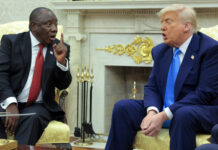
GOLD is expected to retain its commanding position as the world’s second most important monetary reserve for the remainder of 2025.
This is according to analysts cited in The Mining Yearbook 2025 which has been published in Miningmx as a microsite (see link below). Analysts forecast continued strength driven by persistent geopolitical tensions and ongoing de-dollarisation efforts by central banks.
The precious metal’s remarkable 26% rise by June, recording 26 new all-time price highs, has set the stage for what analysts believe will be sustained outperformance. With gold now accounting for 20% of global official reserves according to European Central Bank data, second only to the US dollar’s 46%, the metal appears well-positioned to maintain this elevated status.
Phillip Newman of Metals Focus expects bullion to “break new ground in 2025”, forecasting a record average price of $3,210 per ounce—surpassing the real-terms peak from 1980. Nedbank Securities analyst Arnold van Graan has set an even more ambitious target of $3,200 per ounce average, acknowledging gold’s capacity for surprise. “We believe there is a high probability that gold could test against $3,500/oz again and may even make a run for $4,000/oz,” he notes.
The metal’s resilience appears anchored in persistent underlying conditions. “Gold is probably going to stay strong for some time still until we get a bit more peace in the world,” said Andries Rossouw of PwC. Andrew van Zyl of SRK Consulting notes that “substantial increase in geopolitical stress and conflict” shows little sign of abating, driving nations toward greater self-sufficiency.
Central bank purchases, reflecting broader de-dollarisation efforts, are expected to continue underpinning demand as nations diversify away from US dollar dependency amid mounting geopolitical tensions linked to US trade policy.
The World Gold Council suggests macroeconomic uncertainty will sustain investor interest through year-end. Particularly significant is the potential entry of Chinese insurance companies into the gold market, newly enabled by local legislation, which could prove “transformative to demand, and the price”.
As Investec Securities analysts observe, facing a “bewildering array” of economic conditions including uncertain US tariff policies, “uncertainty is still the only certainty”. They maintain that “gold continues to be our preferred investment metal”, citing its enduring attraction as both a diversifying asset for central banks and a long-term store of value in an increasingly polarised geopolitical environment.









